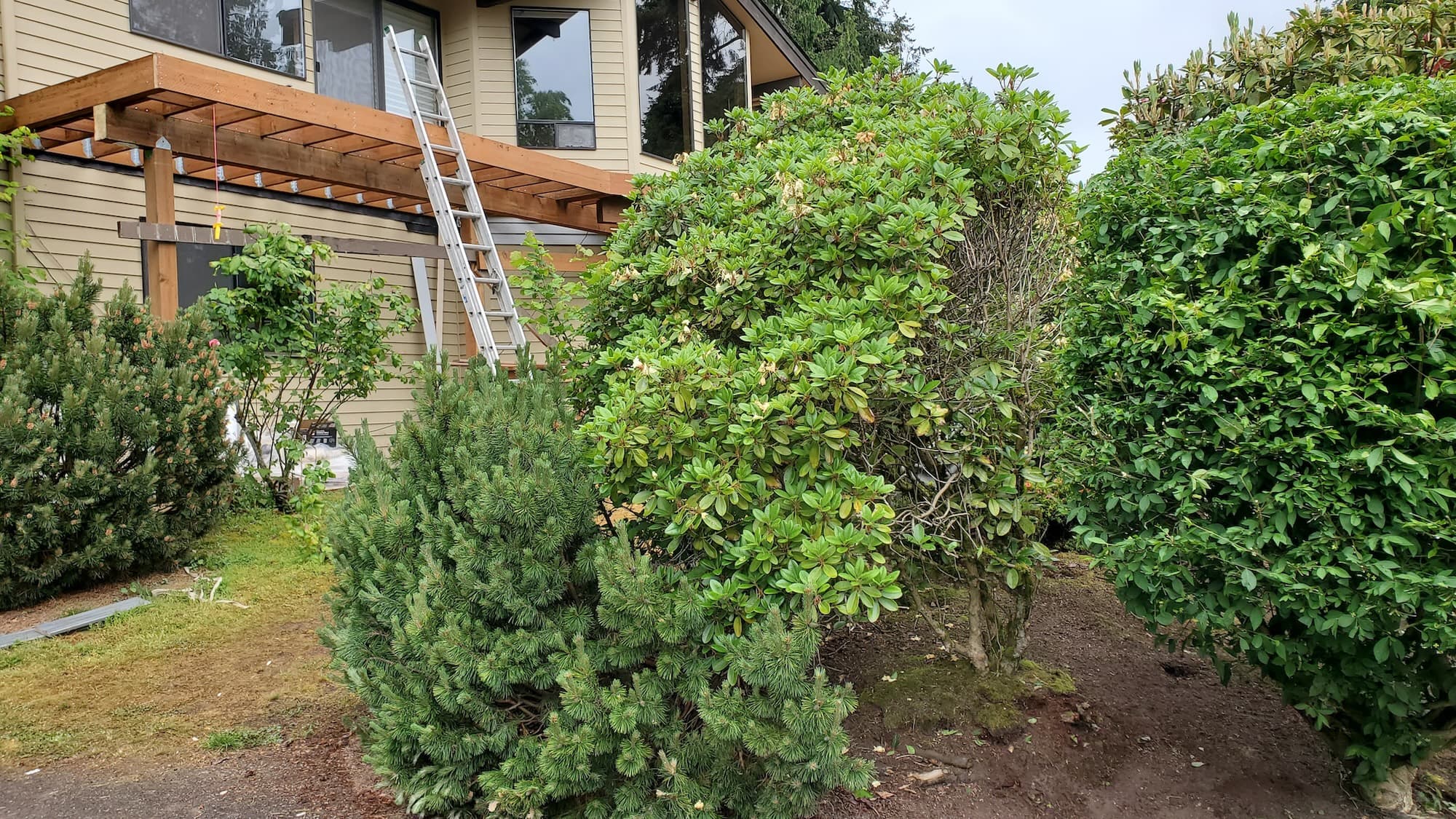West Seattle Laurel trimming
Homeowner’s Issue
Laurel hedges do well in West Seattle’s cool, damp climate, but that doesn’t mean they behave. Most neighborhoods — from Alki’s shoreline lots to the steeper pitches around High Point and the Fauntleroy ridge — deal with heavy winter rain, compacted glacial till, and pockets of shallow topsoil. Those conditions encourage dense, leggy growth at the top while lower branches get shaded out and moss and ivy move in at the base.
Common local problems: poor drainage on slopes, salt spray near the water that scorches exposed edges, and excess leaf litter that holds moisture and invites fungal issues. Homeowners also face HOA sight-line rules on sidewalks and driveways; untrimmed laurels quickly block views and reduce safety at corners. Sun exposure varies block by block — many hedges sit mostly in shade, which slows drying and raises moss/ivy pressure.
For sustainable long‑term health you need selective pruning, attention to root-zone mulch and soil structure, and regular cleanup to prevent debris-built humidity. With proper trimming windows (late spring or after major flower flush), you reduce re-sprouting stress and keep the hedge strong without chemicals. This creates safer sightlines, better curb appeal, and fewer interventions over time.
Our Quality Service
We prune laurel hedges using hand tools and battery-powered trimmers to minimize noise and emissions. Work begins with a health assessment, then selective thinning to open the canopy, shaping to client specs, and root-zone care including organic mulch and soil aeration where needed. For steep lots we rig ladders and use rope access techniques to keep crews safe.
Typical timeline: small hedge — half day; standard front-yard hedge — 2–4 hours; large or overgrown hedges — scheduled as a multi‑day project with a clear scope. We avoid synthetic herbicides entirely, relying on manual removal, organic mulches, and surface soil improvements. Benefits: safer sightlines, reduced pest/mold risk, improved root health, and a low-maintenance profile that meets most HOA and city curb standards.
What’s Included
- Site assessment and pruning plan before cutting.
- Selective thinning and shaping to specified height and line.
- Removal of dead wood, crossing branches, and debris.
- Cleanup: sweep, bed raking, and small-branch chip-up.
- Optional: organic hardwood mulch (yard-friendly depth), soil aeration, and compost top-dressing.
Options / Upgrades
- Mulch + fabric alternative (for very weedy beds).
- Organic weed control (manual removal, steaming, or corn‑gluten where appropriate).
- Haul-away (truck removal) vs. green‑bin drop (city compost) — we discuss local disposal choices.
- Replant suggestions for lower hedge zones (shade-tolerant natives).
Before & After / Expectations
- Mess & noise: expect typical pruning noise for 1–4 hours; battery tools reduce disturbance. We leave the property broom-clean but larger debris may be chipped on-site or hauled away per your choice.
- Access: we need safe ladder access and a 6–8 ft staging area for tools and bundles. Steep or narrow approaches may add time.
- Timelines: routine trims are quick; major reductions or corrections require phased cuts spaced weeks apart to avoid stress.
- Debris handling: choose haul-away (we remove to landfill/yard-waste facility) or green-bin/compost drop (preferred for sustainability).
- Post-service care: water newly exposed root zones lightly during dry July–August weeks, keep 2–3 in of organic mulch away from trunks, and check for moss/ivy encroachment in early fall and spring.
Care tips for West Seattle
- Best trimming windows: late spring after peak bloom or late summer. Avoid heavy structural cuts in late fall when rains increase.
- Watch for moss and ivy in shady, moist sites — hand‑pull or cut back early before seeds set.
- On windy shoreline properties (Alki, north-facing bluff lots) trim slightly lower and denser to act as a windbreak.
FAQs
Q: When is the best time to trim laurel near the coast?
A: Late spring or late summer; avoid major pruning going into the wet season to reduce root stress.Q: Do you use herbicides for regrowth control?
A: No. We use mechanical removal, mulches, and organic approaches only.Q: How long until an overgrown hedge looks tidy?
A: A visual tidy occurs immediately, but structural recovery on heavy cuts can take one growing season; we plan phased reductions if needed.Q: Can you meet HOA sight-line rules?
A: Yes — we measure and document cuts to meet local codes and HOA requirements.Q: What disposal options do I have?
A: We offer haul-away or green‑bin/compost drop. Green‑bin is the lower‑impact choice for most yards.
Call to Action
West Seattle homeowners: if your laurel hedge is blocking a view, crowding the sidewalk, or just overdue for sensible care, book a free estimate. We schedule quick visits, provide clear, written quotes, and focus on sustainable, low‑maintenance outcomes you can live with. Email neatandtidyseattle@gmail.com to request a photo estimate or on-site visit. Trusted local crews, clean work, and practical results.










